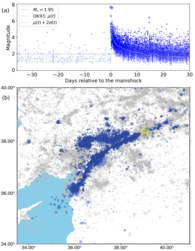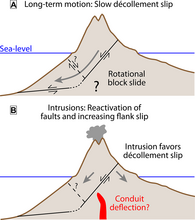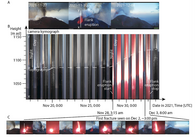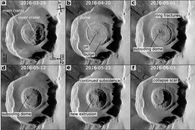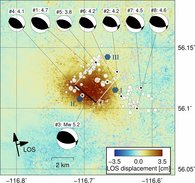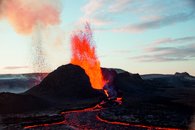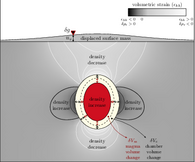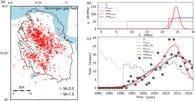The 16 September 2023 Greenland Megatsunami: Analysis and Modeling of the Source and a Week‐Long, Monochromatic Seismic Signal.
Carrillo‐Ponce, A., Heimann, S., Petersen, G. , Walter, T. R., Cesca, S., Dahm, T. (2024)
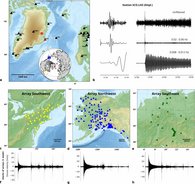
On 16 September 2023, a cascade of events occurred in East Greenland, involving a large tsunami that hit a military unit. Here, we use seismic waveform data recorded on regional to global scales and compare to
high‐resolution satellite images to learn about the cascade of events.We find two distinct seismic signals and develop a conceptual and physical model explaining the observations: initially, the high‐energy seismic signals (0.02–0.06 Hz) occurred, followed by an over one‐week‐long monochromatic signal (0.0109 Hz) recorded even at 5000 km distance. Our single force (SF) inversions characterize both an initial rockslide and the one‐week‐long seiche oscillation processes. The rockslide signal is well reproduced by west and downward SF, with an orientation consistent with observations on satellite imagery. The amplitude decay of the week‐long oscillation, stacked at three teleseismic arrays, is fitted with a damped oscillator model. Using a
simple analytical model of water seiching in a narrow fjord, we can explain the force direction and frequency consistent with the results from SF inversion.
| The Seismic Record 2024, 4 (3) | DOI: https://doi.org/10.1785/0320240013|
Aftershock forecasts based on incomplete earthquake catalogues: ETASI model application to the 2023 SE Türkiye earthquake sequence.
Hainzl, S., Kumazawa, T. , Ogata, Y. (2024)
The Epidemic-Type Aftershock Sequence (ETAS) model is the state-of-the-art approach for modeling short-term earthquake clustering and is preferable for short-term aftershock forecasting. However, due to the large variability of different earthquake sequences, the model parameters must be adjusted to the local seismicity for accurate forecasting. Such an adjustment based on the first aftershocks is hampered by the incompleteness of earthquake catalogs after a mainshock, which can be explained by a blind period of the seismic networks after each earthquake, during which smaller events with lower magnitudes cannot be detected. Assuming a constant blind time, direct relationships based only on this additional parameter can be established between the actual seismicity rate and magnitude distributions and those that can be detected. The ETAS-Incomplete (ETASI) model uses these relationships to estimate the true ETAS parameters and the catalog incompleteness jointly. In this study, we apply the ETASI model to the SE Türkiye earthquake sequence, consisting of a doublet of M 7.7 and M 7.6 earthquakes that occurred within less than half a day of each other on February 6, 2023. We show that the ETASI model can explain the catalog incompleteness and fits the observed earth- quake numbers and magnitudes well. A pseudo-prospective forecasting experiment shows that the daily number of detectable m ≥ 2 can be well predicted based on minimal and incomplete information from early aftershocks. However, the maximum magnitude (Mmax ) of the next day’s aftershocks would have been overestimated due to the highly variable b value within the sequence. Instead, using the regional b value estimated for 2000-2022 would have well predicted the observed Mmax values.
| Geophysical Journal International, 236, 3 | DOI: https://doi.org/10.1093/gji/ggae006|
Interactions of magmatic intrusions with the multiyear flank instability at Anak Krakatau volcano, Indonesia: Insights from InSAR and analogue modeling.
Zorn, E. U., Vassileva, M., Walter, T. R., Darmawan, H., Röhler, L., Amelung, F. (2023)
Volcano flank collapses, which have been documented on ocean islands around the world, can trigger devastating tsunamis. However, little is known about the precursory processes and deformation changes that occur before such collapses. The 22 December 2018 flank collapse at Anak Krakatau in Indonesia is therefore a key event in geosciences. In this study, we provide direct insights into the precursory processes leading up to the collapse. By analyzing interferometric synthetic aperture radar (InSAR) data from 2014 to 2018, we examined the relationship between deformation trends and intrusion events using analogue modeling. Our findings show that the flank was already moving at least four years before the collapse, consistent with slow décollement slip, with movement rates averaging ~27 cm/year. Two periods of acceleration coincided with distinct intrusion events in January/February 2017 and June 2018. Analogue models suggest these accelerations resulted from the (re)activation of a décollement fault linked to brief episodes of magma intrusion. During these intrusions, we observed changes in the internal faults: the outward-directed décollement accelerated, while inward faults became partially blocked. These observations indicate that unstable oceanic flanks do not collapse abruptly; instead, their collapse is preceded by detectable deformations that can be accelerated by new magma intrusions.
| Geology 51, 4 | DOI: https://doi.org/10.1130/G50693.1 |
Late complex tensile fracturing interacts with topography at Cumbre Vieja, La Palma
Walter, T. R., Zorn, E. U., González, P. J., Sansosti, E., Muñoz, V., Shevchenko, A. V., Plank, S. M., Reale, D. and Richter, N. (2023)
Volcanic eruptions are often preceded by episodes of inflation and the emplacement of magma along tensile fractures. In this study, we examine the 2021 Tajogaite-Cumbre Vieja eruption on La Palma, Canary Islands, providing evidence of tensile fractures dissecting the new cone during the eruption's final stage. Using synthetic aperture radar (SAR) observations, drone images, and time-lapse camera data, we determine the timing, scale, and complexities of a fracturing event diverging at a topographic ridge. By comparing our field data with analogue models, we further investigate the details of lens-shaped fractures, which are typical for faults diverging at topographic highs and converging at topographic lows. Our observations at Cumbre Vieja and in our models can be applied to other volcanoes, demonstrating that topography significantly influences the geometry and complexity of fractures, magma pathways, and eruption locations.
| Volcanica, 6 | DOI: https://doi.org/10.30909/vol.06.01.0117 |
Lava dome cycles reveal rise and fall of magma column at Popocatépetl volcano
Valade, S., Coppola, D., Campion, R. et al. (2023)
Lava domes exhibit highly unpredictable and hazardous behavior, making it a significant challenge to image their morphological evolution to understand the underlying governing mechanisms. By utilizing high-resolution satellite radar imagery enhanced with deep learning, we captured the repetitive dome construction-subsidence cycles at Popocatépetl volcano (Mexico) with exceptional temporal and spatial resolution. Our findings reveal that these cycles resemble the gas-driven rise and fall of the upper magma column. Buoyant, bubble-rich magma is extruded from the conduit within hours to days, and then it gradually drains back over days to months as the magma degasses and crystallizes. These cycles are layered over a progressive decadal crater deepening, accompanied by a decrease in heat and gas flux, which may be partially attributed to gas depletion within the magma plumbing system. The results support the idea that gas retention and escape from the magma column are crucial in the short- and long-term morphological evolution of low-viscosity lava domes and their associated hazards.
| Nat Commun 14, 3254 | DOI: https://doi.org/10.1038/s41467-023-38386-9 |
The 2023 Southeast Türkiye Seismic Sequence: Rupture of a Complex Fault Network,
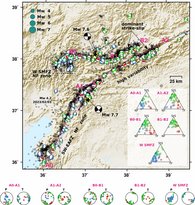
On 6 February 2023, southeastern Türkiye experienced two M w 7.7 and 7.6 earthquakes. The earthquake sequence caused widespread damage and tens of thousands of casualties in Türkiye and Syria. We analyze mainshocks and aftershocks, combining complementary source characterization techniques, relying on local, regional, and teleseismic data. Backprojection analysis and finite source inversion for the mainshocks resolve coseismic slip, rupture length, and propagation mode along the main faults, whereas centroid moment tensor inversion for 221 aftershocks resolves details of the fault network. The first mainshock nucleated on a splay fault and activated the neighboring East Anatolian fault zone (EAFZ). It ruptured bilaterally along ∼500 km first toward northeast and later to south-southwest on multiple, previously partly dormant fault segments. The second mainshock ruptured the east–west-oriented Sürgü-Misis fault zone (SMFZ), reaching a slip of 7 m. The analysis of aftershocks with heterogeneous moment tensors retrospectively reconstructs rupture details. Along the main strand of the EAFZ, they map the geometry of different segments in unprecedented detail, whereas along the SMFZ they illuminate the geometry and behavior of large structures for the first time. Our work sheds light on multiple aspects of rupture evolution and provides new insights into the devastating earthquake sequence.
| The Seismic Record, 3 (2), 134-143 | DOI:https://doi.org/10.1785/0320230008 |
Bayesian inference elucidates fault-system anatomy and resurgent earthquakes induced by continuing saltwater disposal.
An earthquake sequence in western Canada exhibits resurgent aftershocks, possibly in response to persistent, post-mainshock saltwater disposal. Here, we reduce uncertainty in mainshock source parameters with joint inference of interferometric synthetic aperture radar and seismic waveform data, showing that the mainshock nucleated at about 5-km depth, propagating up-dip toward the injection source, and arresting at about 2-km depth. With precise hypocenter relocations and Bayesian inference, we reveal that four subparallel faults were reactivated, likely part of a regional, basement-rooted graben system. The reactivated faults appear to be truncated by a conjugate fault that is misoriented for slip in the present-day stress regime. The nearest saltwater disposal well targets a permeable Devonian reef in direct contact with Precambrian basement, atop a ridge-like uplift. Our observations show that a fault system can be activated more than a decade after saltwater disposal initiation, and continued disposal may lead to a resurgence of seismicity.
| Communications Earth & Environment, 4, 407 | DOI:https://doi.org/10.1038/s43247-023-01064-1|
Depth‐Dependent Aftershock Trigger Potential Revealed by 3D‐ETAS Modeling.
Maleki Asayesh, B., Hainzl, S., Zöller, G. (2023)
Current earthquake catalogs provide high-precision depth values that contain valuable information. Thus, we extend the spatiotemporal Epidemic Type Aftershock Sequence model to 3D by considering hypocentral instead of epicentral distances. To explore the most appropriate parametric form of the spatial kernel, we first examine different triggering functions for the depth difference of the aftershock-mainshock pairs identified by the Nearest-Neighbor method, showing that a magnitude-dependent power-law kernel fits best the earthquakes data in Southern California. Therefore, we incorporate the corresponding kernel into the 3D-ETAS model with space-dependent background activity, where we additionally allow for depth-dependent aftershock productivity. The application to Southern California shows that the model fits the data well. We also find that the aftershock productivity strongly depends on depth, similar to the seismic moment released by the mainshocks, which may be related to depth-dependent seismic coupling.
| Journal of Geophysical Research, 128, 6 | DOI: https://doi.org/10.1029/2023JB026377|
Mechanical Modeling of Pre-Eruptive Magma Propagation Scenarios at Calderas.
L. Mantiloni, E. Rivalta, T. Davis (2023)
Simulating magma propagation pathways requires both a well-calibrated model for the stress state of the volcano and models for dike advance within such a stress field. Here, we establish a framework for calculating computationally efficient and flexible magma propagation scenarios in the presence of caldera structures. We first develop a three-dimensional (3D) numerical model for the stress state at volcanoes with mild topography, including the stress induced by surface loads and unloading due to the formation of caldera depressions. Then, we introduce a new, simplified 3D model of dike propagation. Such a model captures the complexity of 3D magma trajectories with low running time, and can backtrack dikes from a vent to the magma storage region. We compare the new dike propagation model to a previously published 3D model. Finally, we employ the simplified model to produce shallow dike propagation scenarios for a set of synthetic caldera settings with increasingly complex topographies. The resulting synthetic magma pathways and eruptive vent locations broadly reproduce the variability observed in natural calderas.
| Journal of Geophysical Research, 128, 3 | DOI: https://doi.org/10.1029/2022JB025956 |
Cyclical geothermal unrest as a precursor to Iceland’s 2021 Fagradalsfjall eruption.
Flóvenz, Ó. G., Wang, R. , Hersir, G. P., Dahm, T., Hainzl, S. , Vassileva, M. , Drouin, V., Heimann, S., Isken, M. P., Gudnason, E. Á. , Ágústsson, K., Ágústsdóttir, T., Horálek, J., Motagh, M. Walter, T. R., Rivalta,E., Jousset, P. , Krawczyk, C. M., Milkereit. C. (2022)
When a sudden and unexpected unrest period started in January 2020 within the Svartsengi high-temperature geothermal field on the Reykjanes Peninsula, southwest Iceland, scientists immediately deployed instruments to monitor the unrest in detail. A rapid uplift of up to 12 centimetres, accompanied by intense seismicity, was observed in the centre of the high-temperature geothermal field, where important infrastructures are located, including a large geothermal powerplant and the Blue Lagoon Spa.
With this joint effort, the international team of scientists has identified and documented for the first time a precursory process leading to a volcanic eruption on an active oceanic plate boundary where crustal magma chambers are not involved, but magma is directly derived from Earth´s mantle. The results also explain the interaction between magmatic processes and high-temperature geothermal fields and emphasize the role of the brittle-ductile transition in crustal accretion processes at an active oceanic plate boundary. The scientists report on their findings in Nature Geoscience. The paper is a result of a research project by Iceland GeoSurvey (ÍSOR) and GFZ German Research Centre for Geosciences with participation of the Czech Academy of Sciences.
| Nature Geosciencel, 15, 97-4043 | DOI: https://doi.org/10.1038/s41561-022-00930-5 |
Analytical Solutions for Gravity Changes Caused by Triaxial Volumetric Sources.
Nikkhoo, M., Rivalta, E. (2022)
Volcanic crises are often associated with magmatic intrusions or the pressurization of magma chambers of various shapes. These volumetric sources deform the country rocks, changing their density, and cause surface uplift. Both the net mass of intruding magmatic fluids and these deformation effects contribute to surface gravity changes. Thus, to estimate the intrusion mass from gravity changes, the deformation effects must be accounted for. We develop analytical solutions and computer codes for the gravity changes caused by triaxial sources of expansion. This establishes coupled solutions for joint inversions of deformation and gravity changes. Such inversions can constrain both the intrusion mass and the deformation source parameters more accurately.
| Geophysical Research Letters, 49, 8 | DOI: https://doi.org/10.1029/2021GL095442 |
A Coulomb Stress Response Model for Time‐Dependent Earthquake Forecasts.
Dahm, T., Hainzl, S. (2022)
One of the most pressing questions in earthquake physics is understanding where and when earthquakes occur and how seismicity is related to stress changes in the Earth's crust. This question is even more important today because humans are increasingly influencing stresses in the Earth by exploiting the subsurface. So far, two classes of physics-based seismicity models have been used primarily. One assumes instantaneous earthquake occurrence when stress exceeds a threshold, and the other is based on the nucleation of earthquakes according to friction laws determined in the laboratory. Both models are very different in their approaches, have advantages and disadvantages, and are limited in their applicability. In this paper, we introduce a new concept of seismicity models, which is very simple and short to derive and combines the strengths of both previous models, as shown in various applications to human-related seismicity. The forecasts of both traditional models turn out to be special cases of the new model.
| Journal of Geophysical Research, 127, 9 | DOI: https://doi.org/10.1029/2022JB024443 |

